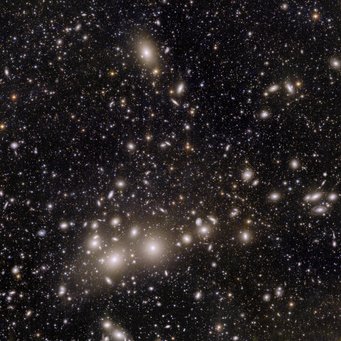Euclid space telescope delivers first scientific images
MPE researchers are excited and are eagerly awaiting the first results.
Euclid, ESA's newest space telescope with strong German participation, released its first colour photos from space today. Never before has a telescope been able to take such sharp astronomical images over such a large area of the sky while looking so deep into the distant universe. The five images show Euclid's full potential. They illustrate that the telescope is poised to produce the most comprehensive 3D map of the universe to uncover some of its dark secrets. The MPE contributed the optics for the NISP instrument and is now hosting one of the nine Science Data Centers for the Euclid consortium, to analyse and process the data.

Euclid's most important task is to make the most detailed 3D mapping of the dark universe ever seen. This special telescope helps to find out how dark matter and dark energy make our universe look the way it does today. 95% of our cosmos seems to be made up of these mysterious “dark” ingredients. While dark matter determines the gravitational effects between and within galaxies and initially caused the expansion of the universe to slow down, dark energy is responsible for its current accelerating growth. However, we do not yet understand what they are made of, as their presence causes only very subtle changes in the appearance and movements of the objects we can see.
To detect the “dark” influence on the visible Universe, Euclid will use its two instruments, VIS (Visible Instrument) and NISP (Near Infrared Spectrometer and Photometer), to observe the shapes, distances and motions of billions of galaxies up to 10 billion light years away over the next six years. As a result, it will produce the most comprehensive 3D cosmic map ever made.
“With the first scientific images and the excellent image quality, especially of our instrument NISP, we are happy and proud to have contributed to these great results,” says Frank Grupp (MPE, LMU), under whose leadership the optics of the NISP instrument were developed and built at MPE. Euclid contains the largest optical lenses ever developed for a scientific space mission. Grupp adds: “We would also like to thank the German Space Agency at the German Aerospace Center (DLR) in Bonn in particular here for their continuous support during all phases of the project.”

Euclid's first look at the cosmos is not only beautiful, but also of great value to science. First, it shows that the Euclid telescope and instruments work extremely well and that astronomers can use Euclid to study the distribution of matter in the Universe and its evolution at the greatest distances. Secondly, each individual image contains a wealth of new information about the nearby universe. In this way, these images take us beyond the realm of dark matter and dark energy and show how Euclid will create a treasure trove of knowledge about the physics of individual stars, the Milky Way and other galaxies.
An example of such observations is the new image of the Perseus galaxy cluster, taken as part of the Early Release Objects (ERO) programme and now published. Matthias Kluge (MPE/LMU): “With Euclid's huge field of view and its high sensitivity, the galaxies in the Perseus Galaxy Cluster can be measured down to their outermost and faintest regions. Together with the numerous globular clusters that we discover in the razor-sharp images, we thus gain new insights into the late stages of galaxy evolution, when galaxies collide and merge.”

What makes Euclid's view of the Universe special is its ability to produce a remarkably sharp visible and infrared image over a large portion of the sky in just one pass. “Euclid will have observed 14,000 square degrees at the end of its mission – 35% of the total sky. The telescope will collect enormous amounts of data and find orders of magnitude more objects than previously possible," Maximilian Fabrizius (MPE, LMU) says. Combined with image data from ground-based telescopes, this will create the largest and most accurate multi-wavelength catalogue in extragalactic astronomy.
Led by Maximilian Fabricius, one of Euclid's nine Science Data Centers is now hosted at MPE, which provides computing hardware as well as pipelines to process the image data. Key elements are first the identification of objects and the determination of their distance and spatial distribution, which allows scientists to analyze accelerated expansion and dark energy. Second, a precise statistical measurement of the shapes of the galaxies makes it possible to use the so-called “weak lensing” effect to determine the distribution of dark matter.
The task now is to evaluate the wealth of data in the coming months and years, which will eventually result in a handsome number of scientific publications. In addition, Euclid's results will lead to further follow-up observations with other telescopes to complete the knowledge about the individual objects.
More images can be found here:
Euclid‘s first images: the dazzling edge of darkness
Background information
Euclid is a space mission of the European Space Agency (ESA) with contributions from the National Aeronautics and Space Administration (NASA). It is the second M-class mission in ESA's Cosmic Vision programme.
VIS and NISP were developed and built by a consortium of scientists and engineers from 17 countries, many from Europe, but also from the USA, Canada and Japan. From Germany, the Max Planck Institute for Astronomy (MPIA) in Heidelberg, the Max Planck Institute for Extraterrestrial Physics (MPE) in Garching, the Ludwig Maximilian University (LMU) in Munich, the University of Bonn (UB), the Ruhr University Bochum (RUB) and the German Space Agency at the German Aerospace Centre (DLR) in Bonn are participating.
The German Space Agency at DLR coordinates the German ESA contributions and also provides funding of 60 million euros from the National Space Programme for the participating German research institutes.
With around 21%, Germany is the largest contributor to the ESA science programme.














